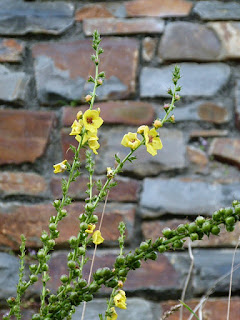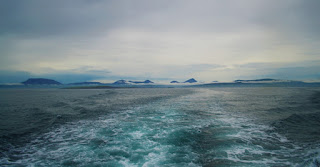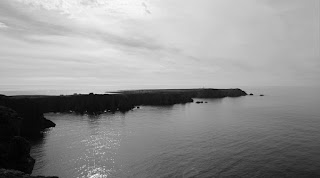 |
| Warren looking up at Sticky Catchfly, Salisbury Crags. Image courtesy of W. Maguire |
I've never been entirely sure where the Botanical Society of Scotland (BSS) ends and BSBI Scotland begins!
But I'm not sure it really matters which hat people wear when botanising. Many Scottish plant-lovers seem to be members of both societies, and in my humble opinion the main thing is that Scottish botanists are doing a great job: they're going out recording, running botanical training courses and conferences and photographic competitions, getting young people involved, taking part in the New Year Plant Hunt and Wildflower of the Month - long may they continue!
So I asked Warren (recent BSBI member) and Ewan (BSS trustee who has just graduated from the University of Edinburgh with a BSc in Plant Science) to tell us about the BSS meeting they led recently in Edinburgh.
Over to Warren and Ewan:
 |
| Ewan (on right) and botanists, Arthur's Seat 19/6/2016 Image courtesy of E. Cole |
"On Sunday the 19th of June, the Botanical Society of
Scotland held its latest field
meeting, ‘The Wildflowers of Arthur’s Seat’, in Edinburgh. Arthur’s Seat is a
volcanic outcrop dominating Holyrood Park in the heart of Scotland’s capital,
and is a Site of Special Scientific Interest (SSSI) and a wonderful place for
wild flowers.
"The site covers an area of 225 hectares and is primarily composed
of lowland grassland habitats, both calcareous and acidic. The close proximity
of the site to the coast and its rocky igneous substrate provide a perfect
niche for a wide range of plant species, some of which are rare locally and
indeed nationally.
 |
| Adder's-tongue Fern Image: W. Maguire |
"Led by Ewan Cole and Warren Maguire, fifteen of us (including
the bryophyte vice-county recorder for Midlothian, David Chamberlain, and the
former president of the Edinburgh Geological Society, Christine Thompson) met
in the sun-bathed carpark in front of the Scottish Parliament at 10.00 a.m.
"The
first place we visited was Hunter’s Bog, an area of damp grassland and marsh
lying between Arthur’s Seat and Salisbury Crags. This area, which is usually
ignored by the many tourists who visit Holyrood Park, holds lots of interesting
plants, including a substantial population of Adder’s-tongue Fern (Ophioglossum
vulgatum). Although these curious little plants can be elusive, there were so
many that we had no difficulty finding them; indeed, they were growing so
thickly amongst the grass that we had to be careful not to stand on any!
"Also
growing in the area were Northern Marsh-orchid (Dactylorhiza purpurella), Yellow-rattle
(Rhinanthus minor), and Hairy Sedge (Carex hirta).
 |
| Purple Milk-Vetch Image: W. Maguire |
"Around the pool at the
centre of Hunter’s Bog, we saw many other marshland species, including
Celery-leaved Buttercup (Ranunculus sceleratus), Brooklime (Veronica beccabunga),
Brown Sedge (Carex disticha), Common Spike-rush (Eleocharis palustris),
Floating Sweet-grass (Glyceria fluitans), and Marsh Horsetail (Equisetum
palustre).
"From Hunter’s Bog, we climbed the long slopes up to
Salisbury Crags where, in addition to spectacular views of Edinburgh and the
Firth of Forth, we were greeted by a blaze of glorious summer colours: the
lemon-yellow of Mouse-ear-hawkweed (Pilosella officinarum), the frothy white of
Heath Bedstraw (Galium saxatile), and pink carpets of Wild Thyme (Thymus
polytrichus).
 |
| Fern-grass Image: W. Maguire |
"Despite the vertiginous nature of the Crags, we spent a good
while here examining these and other specialities of the area including Purple
Milk-vetch (Astragalus danicus), Sand Spurrey (Spergularia rubra), Kidney Vetch
(Anthyllus vulneraria), and Meadow Oat-grass (Avenula pratensis).
"With growing
cloud and wind, we descended to the Radical Road at the foot of Salisbury
Crags. Among the many common wild flowers here were three superficially similar
yellow members of the pea family, Black Medick (Medicago lupulina), Lesser
Trefoil (Trifolium dubium) and Hop Trefoil (Trifolium campestre), and two of
the smaller geraniums, Dove’s-foot Crane’s-bill (Geranium molle) and Hedgerow
Crane’s-bill (Geranium pyrenaicum), all of which provided a good opportunity to
demonstrate the intricacies of identifying superficially similar wild flowers.
"In
addition to masses of Common Rock-rose (Helianthemum nummularium) and Early
Forget-me-not (Myosotis ramosissima), the Radical Road also holds some of
Holyrood Park’s rarest plants, in particular Spring Cinquefoil (Potentilla
tabernaemontani), Fern-grass (Catapodium rigidum), and Sticky Catchfly (Silene
viscaria).
 |
| Spring Cinquefoil Image: W. Maguire |
"We had lunch under a clump of the Sticky Catchfly, high above us on
the Crags and viewable only through our binoculars. These were reintroduced by
Historic Scotland in a bid to bolster the tiny natural population of one of
Britain’s rarest plants in Holyrood Park.
"Our next stop was a brief but fascinating geological
diversion, to Hutton’s Section, which Christine Thompson expertly explained the
significance of. This geological feature, which shows igneous rock overlaying and
intertwining with sedimentary rock, was used by the 18th century Edinburgh geologist,
James Hutton, to demonstrate the complex geological history of the planet.
"Of
course it is the complex geology of Holyrood Park which makes it such a rich
environment for wild flowers, and we were all left feeling like we wanted to
know more about this fundamental aspect of botany.
 |
| Sticky Catchfly Image: W. Maguire |
"By now we were starting to run out of time and weather. It
was clear that we weren’t going to get round all of our planned route, but a
quick walk up Queen’s Drive brought us several other specialities of Holyrood
Park, including Bur Chervil (Anthriscus caucalis), Long-headed Poppy (Papaver
dubium), Bloody Crane’s-bill (Geranium sanguineum), and Forked Spleenwort (Asplenium
septentrionale).
"A climb up the steep slopes to see the original populations of
Sticky Catchfly was, unfortunately, not possible with the group, but again it
was viewed through binoculars. Other treats of Holyrood Park (e.g. Spring
Sandwort, Minuartia verna, Wood Vetch, Vicia sylvatica, Maiden Pink, Dianthus
deltoides, Rock Whitebeam, Sorbus rupicola, and the rare hybrid of Forked
Spleenwort and Wall-rue, Asplenium x murbeckii) would have to wait till another
day, as we were out of time, but everyone who had come along was very pleased
with what we’d seen.
"We parted ways just as the rain came on, having seen about
115 species of vascular plant, many in flower, with a wonderful insight into
the botanical and geological richness of Holyrood Park and Arthur’s Seat.
Thanks to everyone who came along with us and to the BSS for organising and
advertising the meeting!"




























